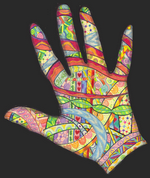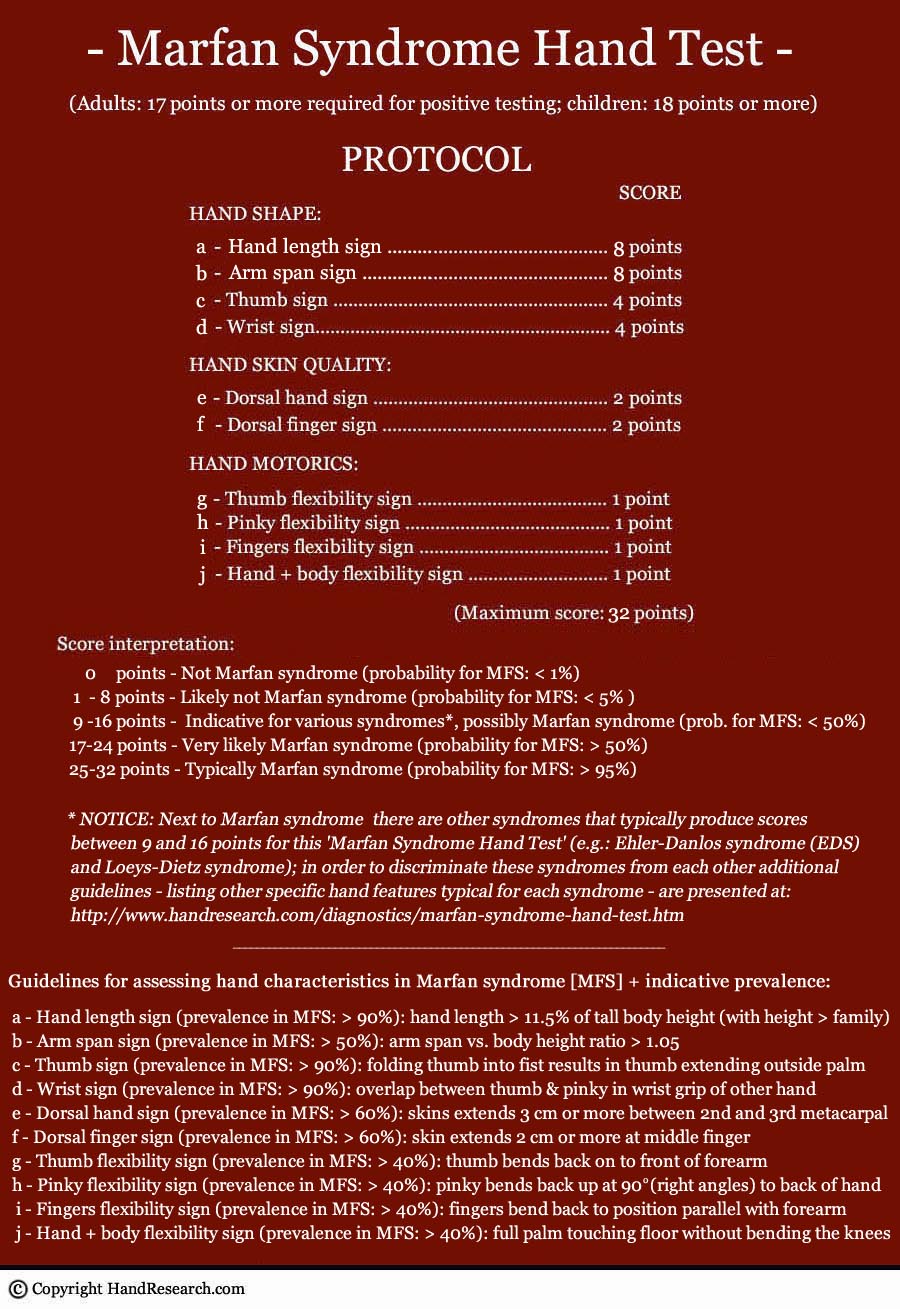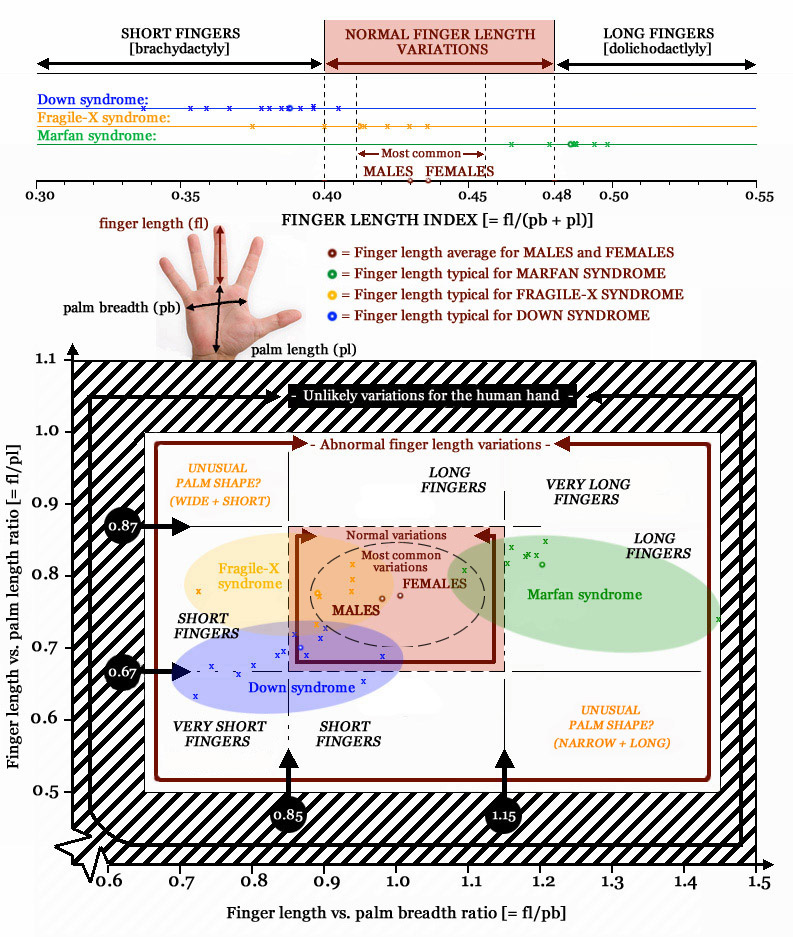None
Most users ever online was 387 on Tue Dec 05, 2023 7:35 pm
The newest registered user is Skylines3
Our users have posted a total of 47502 messages in 4941 subjects
| No user |
• The FREE hand reading services at the Modern Hand Reading Forum are being continued in 2019 with the assistance of Google adsense!

Learn how to read hands according the Modern Hand Reading paradigm & you can use this forum as your palm reading guide!
MARFAN SYNDROME - The language of the hands!
Modern Hand Reading Forum - Discover the language of your hands: palm reading & palmistry forum! :: III - MODERN HAND READING - Various systems for reading hands! :: IIIa - Modern Palmistry: general topics, questions :: IIIf - (Scientific) Multi-Perspective Palm Reading
Page 1 of 2 • 1, 2 
 MARFAN SYNDROME - The language of the hands!
MARFAN SYNDROME - The language of the hands!

Marfan syndrome is a heritable condition that affects the connective tissue which typically manifests typically featured with the presence of rather remarkable body characteristics.
But many people with this disorder are not aware of having it, while they are at risk for an aortic rupture (due to too much stress on the aorta), which is usually fatal. Therefore I have written an introduction about the hand in Marfan syndrome.
About 1 in 3000 persons is known to have Marfan syndrome, but there are estimates which indicate that the true numbers could approach 1 in 1500 persons (because in many people Marfan syndrome has not yet been diagnosed).
Some fascinating typical hand characteristics in Marfan disorder (involving multiple perspectives of the hands) are e.g.: long slender finger, hypermobility, hyperextensible skin, high positioned axial triradius, extra horizontal transverse creases on the fingers & in a significiant minority a simian crease can be found.
More details are available in this blog post:
http://palmreadingperspectives.wordpress.com/2011/05/20/hands-signs-in-marfan-syndrome-thin-fingers-hand-shape-hypermobility/
Hand of woman who has Marfan syndrome... doing a funny 'thumb trick':

Last edited by Martijn (admin) on Sat Jun 04, 2011 9:29 pm; edited 1 time in total
 Re: MARFAN SYNDROME - The language of the hands!
Re: MARFAN SYNDROME - The language of the hands!
Fascinating- I was wondering if there are any psychological characteristics that you have observed- perhaps consistent with water hands, or with observations of hyper-flexibility?
Felicity
 Re: MARFAN SYNDROME - The language of the hands!
Re: MARFAN SYNDROME - The language of the hands!
Hello Felicity,
That's a nice question!
I did a little bit of litererature research on that, and it is interesting to see that these people generally are able to live a happy life, with normal levels of the traits depression and anxiety; but they do tend to develop an introverted personality.
See the quotes from two studies below:
Psychosocial adaptation in adolescents and young adults with Marfan syndrome: an exploratory study.
http://jmg.bmj.com/content/35/5/405.abstract
"Most patients emphasised the need for accurate information about the illness immediately after knowing the diagnosis and all found psychological support helpful. Depression and anxiety levels were higher in the female than in the male group, without being significantly different from the normal population. Nevertheless, most patients have come to terms with their disease and consider themselves happy most of the time."
Determinants of Quality of Life in Marfan Syndrome
http://psy.psychiatryonline.org/cgi/content/full/49/3/243
"In line with these arguments, we found a number of studies indicating that MFS imposes a burden on daily life; in particular, on school attendance; on work opportunities and social behavior; and on the development of an introverted personality, with associated defensive psychological traits, such as denial and isolation."
Obviously... and introverted personality is also associated with a water-hand. But I also think that the 'water hand' is the most vulnerable hand type of all, and generally they tend to be more sensitive for negative emotions (including: depression, anxiety).
But I also think that people with Marfan syndrome tend to have a more 'happy' personality type than one can generally observe in the water hand.
Hopefully, this answers your excellent question...

 Re: MARFAN SYNDROME - The language of the hands!
Re: MARFAN SYNDROME - The language of the hands!
those references were very helpful, also on the web it is fascinating to see that many teenagers and older people with Marfan have videos on You tube- and how they communicate through dance... this is a wonderful outlet for them I feel, and I love the courageous way they express themselves. I was wondering if one of these people could be approached by a professional such as yourself and asked whether they would mind sharing their feelings, their hopes, their fears, their likes etc.
I wonder now, whether some models, who people stereotype as having eating disorders, may be living with Marfan syndrome- potentially undiagnosed. They are so tall and many seem slightly similar to those on videos.
I also was particularly interested in the high positioning of the triaxial radii, as this was observed in the photos on a child's hand in a recent post. I have found this can represent a problem with the heart, valves or aorta. But , a friend who had such a highly placed axial triradii, a result of rheumatic fever, recently had undergone the repairing of the damaged valve and on taking his prints a year later the axial triradii had returned to a 'normal' position.
I know changes can occur in skin ridge patterns- disassociation etc- but had not expected that the axial triraii would.
I would be most interested in your observations and references.
Felicity
 Re: MARFAN SYNDROME - The language of the hands!
Re: MARFAN SYNDROME - The language of the hands!
Felicity Martin wrote:I also was particularly interested in the high positioning of the triaxial radii, as this was observed in the photos on a child's hand in a recent post. I have found this can represent a problem with the heart, valves or aorta. But , a friend who had such a highly placed axial triradii, a result of rheumatic fever, recently had undergone the repairing of the damaged valve and on taking his prints a year later the axial triradii had returned to a 'normal' position.
I know changes can occur in skin ridge patterns- disassociation etc- but had not expected that the axial triraii would.
I would be most interested in your observations and references.
Felicity
Hi Felicity,
Did your friend's ridges become so broken up (i.e. string of pearls) and dotted that the triradius was no longer visible? It's supposed to be impossible for a triradius to relocate. Were you able to get prints?

Patti- Posts : 3912
Join date : 2010-07-24
 Re: MARFAN SYNDROME - The language of the hands!
Re: MARFAN SYNDROME - The language of the hands!
Felicity Martin wrote:...
I wonder now, whether some models, who people stereotype as having eating disorders, may be living with Marfan syndrome- potentially undiagnosed. They are so tall and many seem slightly similar to those on videos.
... As a matter of fact, last year Marfan syndrome was mentioned in an episode of 'America's Next Top Model', see:
http://www.huffingtonpost.com/2010/08/17/tyra-banks-responds-to-to_n_684712.html
And here's even a story of a Marfan 'miss teen':
http://www.missteeninternational.us/contestantdetails.php?id=207
(Though I think even this Marfan beauty can hardly compete with the other girls because she probably does not have enough 'hip-to-waist ratio'... and by the way, working as a model is usually a stressfull life, and that means always a significant risk factor regarding the heart problem, etc.)

 Re: MARFAN SYNDROME - The language of the hands!
Re: MARFAN SYNDROME - The language of the hands!
Felicity Martin wrote:...
I also was particularly interested in the high positioning of the triaxial radii, as this was observed in the photos on a child's hand in a recent post. I have found this can represent a problem with the heart, valves or aorta. But , a friend who had such a highly placed axial triradii, a result of rheumatic fever, recently had undergone the repairing of the damaged valve and on taking his prints a year later the axial triradii had returned to a 'normal' position.
Yes Felicity,
The 'high positioned axial triradius' is indeed a very significant clue regarding hands & heart problems - though it is often not a reliable indicator (because there is no direct relationship at all).
So, just like regarding the example of the simian line & Down syndrome... one always has to consider the other aspects of the hand in order to evaluate whether the link could become significant for an individual.
PS. People who have Down's syndrome (or other trisomy syndromes) are nearly always featured with a high positioned axial triradius, and about half of these people have an inborn heart problem.
 Re: MARFAN SYNDROME - The language of the hands!
Re: MARFAN SYNDROME - The language of the hands!
...Nice to see that this forum discussion was introduced at:
Marfan Syndrome on CrossingFingers.com
 Re: MARFAN SYNDROME - The language of the hands!
Re: MARFAN SYNDROME - The language of the hands!
A few more typical impressions for the hand in Marfan syndrome:



 Re: MARFAN SYNDROME - The language of the hands!
Re: MARFAN SYNDROME - The language of the hands!
During the past year my 'Multi-Perspective Palm Reading' blog attracted many responses from people interested in Marfan syndrome.
Therefore I decided to take the Multi-Perspective Palm Reading approach one step further for Marfan syndrome, by introducing a new test: the 'Marfan Syndrome Hand Test':
http://www.handresearch.com/diagnostics/marfan-syndrome-hand-test.htm
I hope this provides a better understanding of why a multi-perspective approach towards the hand is necessary for finding reliable results, and a better understanding of what type of hand characteristic combinations makes the hand in Marfan people unique compared to the hands of non-Marfan people.
PS. Beyond this brand new test, I have featured this page also with some famous hand examples of Marfan people (including impressions & hand analyses of the famous Italian violinist Niccolò Paganini and the famous Russian pianist Sergei Rachmaninoff).


 Re: MARFAN SYNDROME - The language of the hands!
Re: MARFAN SYNDROME - The language of the hands!
Plenty of feedback on the 'Marfan syndrome hand test' is already available at facebook:
https://www.facebook.com/groups/2204143971/permalink/10150943650313972/
 Re: MARFAN SYNDROME - The language of the hands!
Re: MARFAN SYNDROME - The language of the hands!
... The feedback from the Marfan community at Facebook made me able to improve the hand-test significantly - with references to 2 other syndromes that have quite a few overlapping hand features with Marfan syndrome; plus I have added a simple criterium for discriminating Marfan syndrome from the other syndromes:
Because long (thin) fingers combined with arm span longer than the typically tall (slender) body height [with a ratio > 1.05] is another key-factor which nearly always discriminates Marfan syndrome from the other related syndromes (including the so-called Ehler-Danos syndrome, which used to be known as Marfan type 2 syndrome until it became re-discovered only a few years ago).
 Re: MARFAN SYNDROME - The language of the hands!
Re: MARFAN SYNDROME - The language of the hands!
UPDATE:
The hand-test has now been REVISED:
The 'arm span sign' (which e.g. reflects hand length) is now included in this test as a 9th key-sign for Marfan syndrome (introduced in the test as item 'c').
PS. This essential change results in a much higher correlation with the so-called 'systemic score for Marfan syndrome' (which is included in the 6th rule of the 'Ghent nosology' - that is since 2010 a.k.a. the official set of rules to be used for making a diagnosis for Marfan syndrome).
 Re: MARFAN SYNDROME - The language of the hands!
Re: MARFAN SYNDROME - The language of the hands!
Could you tell by just looking at a pair of hands if their owners had Marfan's?
Also, would an exceptionally tall thin woman, over 6', with radial loops on ring and little finger of right hand be a candidate?

Patti- Posts : 3912
Join date : 2010-07-24
 Re: MARFAN SYNDROME - The language of the hands!
Re: MARFAN SYNDROME - The language of the hands!
Patti wrote:Martijn,
Could you tell by just looking at a pair of hands if their owners had Marfan's?
Also, would an exceptionally tall thin woman, over 6', with radial loops on ring and little finger of right hand be a candidate?
Hi Patti,
I think Marfan syndrome has proven to be a complicated disorder that manifests via many different (individual) patterns of combinations. So this is usually a matter of finding enough clues from different perspectives:
Regarding your first question: yes, I think so - though I would need to have the person in front of my in order to see if the owner is able to make the signs included in the hand-test, etc.
Regarding your second question: my answer would be that in Marfan syndrome the fingerprints probably reveal very little info (palmar dermatoglyphics appear to be involved much more but it is not easy to describe how). Regarding the length of this woman, I guess it would be essential to know whether her length exceeds the length of family members (including the males!?)... if so that could become a ground to proceed. However, from your input so far this woman has a higher chance for turning out to be a (wannabee) supermodel... or maybe a young woman with an eating disorder? Thus, so far I would say: likely not a 'candidate' - because the combination that you described includes not enough clues to validate the possibility for Marfan syndrome.
I hope this makes sense?
Thank you for your input.

 Re: MARFAN SYNDROME - The language of the hands!
Re: MARFAN SYNDROME - The language of the hands!
I first read the granddaughter, about 11 or 12, who was of normal height and round in shape. I had noticed the tall lady in the crowd in the back ground. The grand daughter had the most unusual 'missing C' I've ever seen and asked to take photos. She was so excited about her reading that she told her grandmother who turned out to be the tall lady. I was excited to compare the dgs and take her photos, too. She has a loop in the same place as the odd ridges were in the granddaughter's palm, which explained somewhat the differences.
I may have read another granddaughter as I asked to take photos of a girl with a comb pattern between the middle and ring fingers, missing C and B is almost not there... it took zooming in on the image on my monitor to see it. I originally thought both C and B were missing. There were similarities between the two girls.
The grandmother has many extra creases and deep ones even on the distal tips, which I don't usually see except for thumb. Radial loops on ring and little on right and radial peacock on ring on the left. She looked healthy just taller than usual and slender.

Patti- Posts : 3912
Join date : 2010-07-24
 Re: MARFAN SYNDROME - The language of the hands!
Re: MARFAN SYNDROME - The language of the hands!
Yes, I agree Patti: I might not be able to help you out here... except by pointing out that what you described for the lady's hands does not include any clue at all that could point in the direction of Marfan syndrome.
Maybe it was just the Lady's slender body height that made you think of Marfan?
 Re: MARFAN SYNDROME - The language of the hands!
Re: MARFAN SYNDROME - The language of the hands!
A 10th hand sign has now been added to the 'Marfan Syndrome Hand Test': the 'hand length sign', see:
http://www.handresearch.com/diagnostics/marfan-syndrome-hand-test.htm
Additionally, the article now presents a list of 8 other hand signs that are significant for recognizing Marfan syndrome.
'Dolichonychia' (= long, narrow fingernails with a ratio above 1.3) is another new sign listed - which is known to be very significant for women who have Marfan syndrome (up to 75% of Marfan women may have it, for men the percentage is above 15% - while in non-Marfan women the percentage is about 2.5%, non-Marfan men: below 1%). Some visual impressions of this nail shape feature are presented here:
http://journals.lww.com/smajournalonline/pages/imagegallery.aspx?year=2004&issue=04000&article=00011
PS. Earlier today I have just reveiced some early feedback from 2 people who have Marfan syndrome - both passed the test! (While one of these persons had not qualified for the first version of the hand test that did not include the 'hand length sign' and the 'arm span sign')

 Re: MARFAN SYNDROME - The language of the hands!
Re: MARFAN SYNDROME - The language of the hands!
Just posted at the Marfan syndrome facebook forum:

https://www.facebook.com/groups/2204143971/permalink/10150978224708972/
"A QUICK SUMMARY OF THE FEEDBACK ON THE MARFAN SYNDROME HAND TEST SO FAR:
The hand test works pretty well for those who have Marfan syndrome: 6 out of 8 Marfan people directly passed the test (all with scores 24 or higher); 2 Marfan people arrived in the 'borderline category' (11 points and 16 points), but an analyses of the scores involved indicates that scoring points for the 'arm span' (or the former 1.03 ratio criterium) is a key-factor: one of these 2 Marfan people passed the 1.05 ratio and the other person does qualify for the 1.03 ratio (and has body height exceeding family members).
NOTICE: So far two EDS people have performed the hand test as well: both score in the 'borderline category' (9 points and 10 points), however both do not qualify for the 'arm span sign' and both also do not have excessive body height.
Finally one person who was diagnosed for LDS (type 2b - previously known as Marfan syndrome type 2) did the revised hand test and passed it as well - however, interestingly, this person was diagnosed as Marfan syndrome (before LDS was discovered in 2006).
Therefore so far all feedback indicates that the hand test does discriminate Marfan syndrome [MFS] from Ehler-Denos syndrom [EDS].
Regarding Loeys-Dietz syndrome, I am confident that in far most cases the hand test will not result in a positive score for Marfan syndrome, however there is a considerable chance that a significant percentage of the people who have the LDS-type 2b variant might pass the Marfan syndrome hand test (which implicates that the LDS-type 2b group has a significant risk for getting a 'false positive score' on this hand test).
I think this is pretty fascinating."
 Re: MARFAN SYNDROME - The language of the hands!
Re: MARFAN SYNDROME - The language of the hands!
New update:
14 out 17 Marfan people passed the hand-test (the other 3 Marfan people scored in the 'border line' category), see:
https://www.facebook.com/groups/2204143971/permalink/10150978224708972/
PS. Still only 1 single 'false positive' (= the person who has Loeys-Dietz syndrome, which used to be known as 'Marfan syndrome - type 2')
 Re: MARFAN SYNDROME - The language of the hands!
Re: MARFAN SYNDROME - The language of the hands!
... One more aspect about the hand in Marfan syndrome:
In the literature about Marfan syndrome 'spider fingers' (a.k.a. arachnodactly - which means: long slender fingers) are described as a key-feature in Marfan syndrome.
However, my study of the hand in Marfan syndrome made me realize that this typical feature has not been described very well - because so far there has been no 'hard' criteria for discriminating arachnodactyly from normal fingers.
The picture below describes precisely how to recognize 'abnormal long fingers' (technically scientists call it 'dolichodactyly') in Marfan syndrome. Because in Marfan syndrome finger length only presents an atypical feature when finger length is compared to the breadth (palm) of the palm... but not when finger length is compared to the length of the palm!
PS. I should add here that in Marfan syndrome the ratio between finger length and palm length will usually turn out to be slightly higher than the international average for men and women (see the picture below: 7 out 8 Marfan hands score above average on the 'finger length / palm length' dimension - but still within the 'normal range'... only on the 'finger length / palm breadth' dimension the scores are beyond the 'normal range').
EDIT: Picture has now been updated with the 'finger length index': 6 out of 8 Marfan hands have abnormally long fingers (= dolichodactyly).

Last edited by Martijn (admin) on Fri Jul 13, 2012 10:34 pm; edited 2 times in total
 Re: MARFAN SYNDROME - The language of the hands!
Re: MARFAN SYNDROME - The language of the hands!
I can't find any reference to it on the internet (apart from where you have written it).
Closest word I found was oligodactyly (fewer than 5 fingers or toes on a hand or foot).
 Re: MARFAN SYNDROME - The language of the hands!
Re: MARFAN SYNDROME - The language of the hands!
Thanks Lynn... I somewhere lost the first letter of the word, I have corrected the error - the word is now correctly written as: 'dolichodactyly'.

 Re: MARFAN SYNDROME - The language of the hands!
Re: MARFAN SYNDROME - The language of the hands!
How would you classify these? I have close ups of palms and fingers if you need to double check anything.

p.s.: I realize you can't get actual measurements, but I thought you would be able to get ratios.

Patti- Posts : 3912
Join date : 2010-07-24
 Re: MARFAN SYNDROME - The language of the hands!
Re: MARFAN SYNDROME - The language of the hands!
Hi Patti,
The photo gives me the impression that this person's finger length is clearly above the international average (both hands), with the right hand (displayed at the left) very close the category (abnormal) 'long fingers' in the perspective of palm length.
However, I should add here that due to the camera position I expect that the fingers are actually slightly shorter (and the palm slightly longer) than seen in this photo.
PS. Just wondering why you posted this photo in the Marfan topic... can this person any how be connected with Marfan syndrome?
Page 1 of 2 • 1, 2 
 Similar topics
Similar topics» DOWN SYNDROME - The language of the hands!
» SCHIZOPHRENIA - The language of the hands!
» BLOG REPORT: "Little hands" (Down's syndrome)
» JEREMY BEADLE'S HANDS - King of jokes had a small little baby hand! (Poland syndrome)
Modern Hand Reading Forum - Discover the language of your hands: palm reading & palmistry forum! :: III - MODERN HAND READING - Various systems for reading hands! :: IIIa - Modern Palmistry: general topics, questions :: IIIf - (Scientific) Multi-Perspective Palm Reading






» Teacher square on my Jupiter mount
» Handreading International Conference 2024
» Can anyone read it for me?
» Are there any signs in the hands that you are a twin flame?
» Square on Marriage line
» Cross in mount Jupiter
» clinodactyly: top phalanges bending towards Mercury finger
» Can anybody please read this hand
» Nisha Ghai
» Absolutely non-sense career till now
» Fate Destiny Line -
» VIII - Palmistry books TOP 100 - listed by 'Amazon Sales Rank'!
» Stewart Culin - Palmistry in China and Japan
» Herbert Giles - Palmistry in China